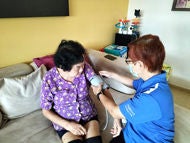What is - Snoring
What is snoring?
Snoring is a sound that is produced due to vibration of tissues in the throat. Studies have shown that approximately 24% of the local population are loud habitual snorers.
Snoring is usually not harmful, but it can be a symptom of upper airway obstruction – this medical condition is known as obstructive sleep apnoea (OSA).
OSA is a potentially serious disorder, in which one’s breathing is interrupted during sleep resulting in a drop in oxygen levels in the body. This causes the individual to awaken many times during the night, experience unrefreshed sleep and excessive daytime sleepiness (EDS).
Many people snore, but only some snorers have OSA.
What are the potential complications of OSA?
In patients with OSA, repeated drops in blood oxygen levels every night lead to multiple health issues if left untreated. Complications of untreated OSA include:
- Hypertension
- Diabetes mellitus
- Stroke
- Acute myocardial infarction (heart attack) or heart failure
- Cardiac arrhythmias (abnormal heart rhythm)
- Obesity
- Motor vehicle accidents (due to excessive daytime sleepiness)
- Cognitive impairment and dementia
- Normal tension glaucoma
- Sexual or erectile dysfunction
Snoring - Causes and Risk Factors
What causes snoring?
Snoring is a sound that is produced due to vibration of tissues lining the upper air passages. It is usually due to a combination of factors that eventually lead to narrowing or collapse of the upper air passage. These factors include:
- Relaxation of muscles during sleep
This causes the walls of the upper airway to fall together and narrow, causing them to vibrate. The tongue may fall back into the throat when sleeping on the back and contribute to snoring. - Nasal blockage
Nasal blockages due to conditions such as nasal allergies, deviated nasal septum, turbinate hypertrophy, nasal polyps or large adenoids can cause poor nasal airflow and mouth breathing, making the situation worse. - Large tonsils, bulky tongue or a long soft palate can narrow the airway
What are the risk factors for snoring?
Other factors which can influence the snoring condition are:
- Genetics: Individuals with a smaller or receded chin are at higher risk of OSA. Genetic predisposition leading to facial and jaw abnormalities are also predisposing risk factors.
- Obesity: Fat is deposited in the tongue and soft palate when individuals gain weight. Excessive neck fat also compresses on the upper air passages, further narrowing the upper airway.
- Ageing and associated loss of general muscle tone
- Gender: Males are more likely to snore.
- Congestion of the throat due to reflux of stomach acid (heartburn)
- Medications/alcohol: Mild or intermittent snoring may be a result of medications (like sedatives to help you sleep) or alcohol that induces relaxation of the upper airway muscles.
- Smoking: Smoking causes inflammation and swelling of the upper airways.
Diagnosis of Snoring
When should you see a doctor?
Consult your physician if you have these symptoms in addition to loud snoring, as you may possibly have OSA:
- Choking or breathing pauses during sleep
- Unrefreshed sleep
- Morning headaches
- Excessive daytime sleepiness
- Poor concentration or memory
- Frequent urination at night
Your physician will then refer you to a Sleep Disorders Centre for a thorough evaluation of your problem.
How is snoring diagnosed?
At the Sleep Disorders Centre, the attending Specialist will schedule a sleep study to evaluate the severity of your upper airway collapse and drops in oxygen level during sleep. A sleep study is required to diagnose OSA. This sleep study can be done overnight in the hospital or at the comfort of your own home.
Treatment for Snoring
How is snoring treated?
The treatment of snoring and OSA requires a multidisciplinary approach and is divided into medical and surgical options. The eventual therapeutic choice is individualised.
Conservative treatment
- Weight loss
- Avoidance of alcohol or other medications: Avoid consuming alcohol after 6pm – alcohol causes relaxation of muscles and swelling of the tissues of the airway. Avoid taking sleeping pills – certain sleeping pills may cause the upper airway to relax, which leads to snoring.
- Treatment of nasal congestion with medications
- Continuous positive airway pressure (CPAP) device supplies pressurised air into the upper airway via a mask, keeping the upper airway constantly open thereby eliminating snoring.
- Dental appliances that hold the jaw in a forward protrusive position during sleep have also been used to treat snoring and OSA.
Surgical treatment
Surgical procedures for the treatment of snoring and OSA may include nasal, palate, jaw, tongue or neck surgery depending on the location of the tissues contributing to the upper airway obstruction.
A comprehensive assessment by an ear, nose and throat (ENT) surgeon is required prior to surgery, as surgical recommendations are tailored to individuals. This usually involves an upper airway endoscopy under sedation to evaluate the areas of your upper airway collapse during sleep.
Most treatments are directed at the soft palate (soft tissue at the back of the roof of the mouth) since this is the most common site of snoring. Some snorers have excessive tissue such as large tonsils, long palate and bulky tongue. Removal of such excessive tissues will help alleviate snoring.
Types of surgery include:
- Nasal surgery: Nasal airway obstruction caused by bony, cartilaginous or enlarged tissues can interfere with nasal breathing during sleep. An open nasal airway establishes normal breathing and minimises mouth breathing. Mouth breathing in OSA individuals worsens the upper airway by allowing the tongue to fall back. Establishing an open nasal airway passage can also improve CPAP tolerance and compliance. Techniques include straightening the septum, reducing the size of the inferior turbinates and nasal valve reconstruction.
- Tongue or palatal surgery: Individuals who snore tend to have a narrow, floppy and elongated soft palate. Their tongues tend to be bulky as well. Techniques such as radiofrequency soft palate, uvulopalatopharyngoplasty or coblation tongue channeling can be used to tighten the soft palate and reduce the tongue size. In carefully selected patients, the success rate may be up to approximately 60%.
- Tongue base and epiglottis surgery: In some individuals, enlarged lingual tonsils at the tongue base or an elongated floppy epiglottis contribute to their snoring and OSA. In these cases, surgery can be performed to reduce the size of the excessive lingual tonsils or slightly shorten the length of the epiglottis to reduce floppiness.
- Maxillomandibular advancement surgery: Maxillomandibular advancement surgery is a more aggressive procedure, usually recommended for individuals with a receded chin. It involves forward movement of the lower jaw and midface, which opens the upper airway at the back of the throat.
- Hypoglossal nerve stimulation implant surgery: This surgery is recommended for individuals with moderate to severe OSA. It involves the placement of an implant in the chest, which sends electrical signals via a conducting wire to stimulate the tongue nerve (hypoglossal nerve). This causes the tongue to stiffen and protrude slightly which prevents the tongue from falling back into the throat during sleep, thereby keeping the upper airway patent.
FAQs on Snoring
- Sleep on your side and avoid sleeping on your back – sleeping on your back causes your tongue to fall into your throat, which worsens snoring.
- Quit smoking – smoking causes swelling of the tissues of the airway, which results in snoring.
- Allow your bed partner to fall asleep before retiring to bed.
- Provide ear plugs for your bed partner.
Snoring - Other Information
Some Useful Suggestions for Snorers
- Try to lose weight if you are obese
- Avoid taking sleeping pills – certain sleeping pills may cause the upper airway to relax, which leads to snoring
- Avoid consuming alcohol after 6pm – alcohol causes relaxation of muscles and swelling of the tissues of the airway
- Sleep on your side and avoid sleeping on your back – some people snore, or snore heavily only when sleeping on their back
- Quit smoking – smoking causes swelling of the tissues of the airway, which results in snoring
- Allow your bed partner to fall asleep before retiring to bed
- Provide ear plugs for your bed partner

Download Snoring Brochure [ PDF | 2.7MB ]
Contributed by
The information provided is not intended as medical advice. Terms of use. Information provided by SingHealth.
Condition Treated At
Department
Otorhinolaryngology - Head &Neck Surgery
Department
Otolaryngology (ENT)
Department
Otorhinolaryngology- Head & Neck Surgery
Get to know our doctors at SingHealth Hospitals in Singapore.
Get to know our doctors at SingHealth Hospitals in Singapore. here.





















